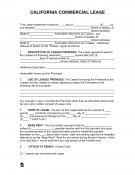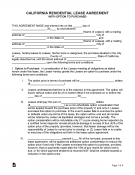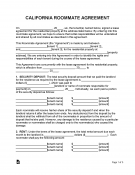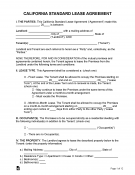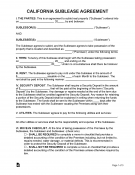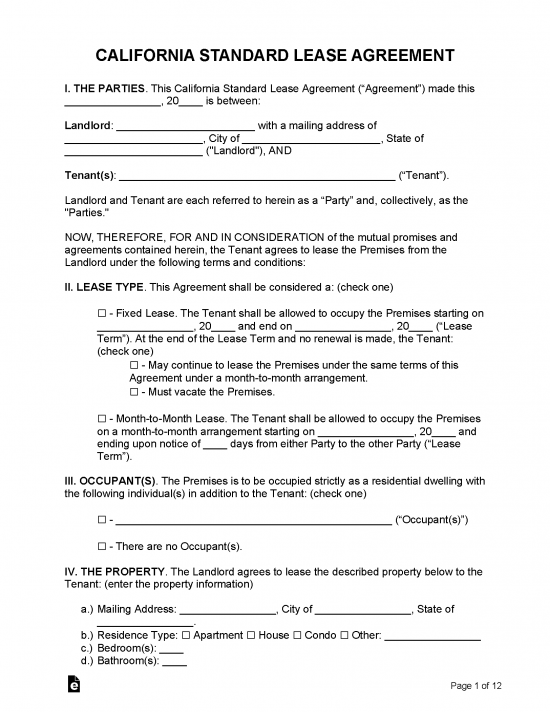California lease agreements are contracts that set out the terms of a tenant’s occupancy of a landlord’s property. They include how much rent is owed each month, and what rights the landlord and the tenant have. The landlord and the tenant should each keep a copy of the lease agreement and refer to it in the event of a disagreement.
Contents
- California Lease Agreements: By Type (6)
- Landlord-Tenant Laws
- Handbooks and Guides
By Type (6)
- Commercial Lease Agreement
- Lease-to-Own Agreement
- Month-to-Month Lease Agreement
- Roommate Lease Agreement
- Standard Lease Agreement
- Sublease Agreement
Download: Adobe PDF, MS Word, Rich Text Format
 Month-to-Month Lease Agreement
Month-to-Month Lease Agreement
Download: Adobe PDF, MS Word, Rich Text Format
Download: Adobe PDF, MS Word, Rich Text Format
Download: Adobe PDF, MS Word, Rich Text Format
Download: Adobe PDF, MS Word, Rich Text Format
Download: Adobe PDF, MS Word, Rich Text Format
Landlord-Tenant Laws
Statutes – Cal. Civ. Code Division 3, Part 4, Title 5, Chapter 2 (Hiring of Real Property)
Required Disclosures (11)
AB 1482 Just Cause Addendum (CIV 1946.2(e)(8)(B)(i) & 1947.12(d)(5)(B)(i)) – This form must be signed by all tenants for landlords unless it falls into one of the following categories of exemptions:
- Units constructed in the last 15 years;
- Units restricted by a deed, regulatory restrictions, or other recorded document limiting the affordability to low or moderate-income households;
- Certain dormitories owned and operated by an institution of higher education or a kindergarten and grades 1 to 12;
- A 2-unit property provided the owner occupies one of the units; and
- Single-family homes only if they are not owned by a real estate trust, a corporation, or an LLC with at least one corporate managing member;
- Units that are already subject to a local rent control ordinance.
Bedbug Addendum (CIV § 1942.5(a)(1)) – This form allows both the tenant and the landlord to confirm that there are neither prior nor current infestations of particular insects.
Demolition (CIV § 1940.6) – If the landlord has received any type of permit from their respective municipal office to demolish a residential unit it must be disclosed to the tenant before accepting a rental contract or deposit.
Flood Disclosure (PDF, MS Word, ODT) (GOV § 8589.45) – Mandatory as of July 1, 2018. The lessor is required to inform the tenant if the property is located in any special flood area.
Lead-Based Paint Disclosure – For any housing type built prior to 1978 to notify the habitants of the unit that the hazardous material of lead paint may exist in the under-layers of paint in their walls/ceilings.
Megan’s Law Disclosure (CIV § 2079.10a) – The following statement is required to be in every residential contract written in California:
“Notice: Pursuant to Section 290.46 of the Penal Code, information about specified registered sex offenders is made available to the public via an Internet Web site maintained by the Department of Justice at www.meganslaw.ca.gov. Depending on an offender’s criminal history, this information will include either the address at which the offender resides or the community of residence and ZIP Code in which he or she resides.”
Mold Disclosure (HSC § 26147 & 26148) – The landlord must disclose the potential health risks of mold by attaching the document to the agreement.
Ordnance Locations (CIV § 1940.7(b)) – The landlord of a residential dwelling unit who has actual knowledge of any former federal or state ordinance (explosive) locations in the neighborhood area shall give written notice to a prospective tenant of that knowledge prior to the execution of a rental agreement.
Pest Control (GOV § 1099) – If any remediation has been conducted on the property, an inspection report provided by the pest control company must be also forwarded to the tenant.
Shared Utilities (CIV § 1940.9) – If the unit has a shared electrical or gas meter, the agreement must state how the utilities shall be split between the parties, such as through co-metering.
Smoking Policy Disclosure (CIV § 1947.5) – Landlord must state if smoking is tolerated, and if so where it is allowed, including common area policies.
Optional Disclosures
Asbestos Addendum – To advise as to the existence of asbestos on a property
Carbon Monoxide Detector Compliance Form (§ 17926.1) – A landlord must have carbon monoxide monitors in all units with fossil-fuel-based heaters and/or appliances.
CC&Rs Addendum – CC&Rs stands for covenants, conditions, restrictions, and association rules and regulations.
Grilling Guidelines – Provides rules for tenant’s grill use
Move-In/Move-Out Inspection Checklist – A comprehensive list of features in a typical dwelling, with places to mark conditions on move-in and on move-out. Typically, the cost to address differences in condition will be made up out of a tenant’s security deposit.
Personal Guarantee – This provides a person’s written promise to pay the amount owed in rent. Typically used for high-risk tenants, to provide a co-signer.
Pet Agreement – For landlords that allow tenants to have pets.
Pool & Hot Tub Addendum – If the unit has a pool or jacuzzi on the premises, this form can identify rules and expectations.
Renter’s Insurance Addendum – If the landlord requires the tenant to have liability insurance.
Resident Policies and House Rules – Provides policies on rules for tenants during the time on the premises.
Satellite Dish Addendum – Tenants in California have the right to install a satellite dish on the property, provided doing so conforms to other state and local laws.
Unlawful Activities Addendum – Neither tenants nor guests may commit criminal acts on a property; this form shows that removal (eviction) will follow if they do.
Other disclosure forms may be available on the Apartment Association of California’s Index Page.
Security Deposit Laws
Maximum Amount ($)
A landlord may charge no more than two (2) times the monthly rent for a security deposit for an unfurnished unit and no more than three (3) times the monthly rent for a furnished unit (§1905.5(c)).
Returning to Tenant
Within a reasonable amount of time of either the landlord or the tenant indicating a plan to end the tenancy, the tenant can request an inspection to see what damage may have been done to the unit that is eligible to be deducted from the security deposit.
The landlord must present to the tenant an itemized list of deductible faults found in this inspection, and the tenant must have an opportunity to correct them before moving out. After the tenant leaves, the landlord has twenty-one (21) days to provide an itemized list of deductions from a post-move inspection, and the landlord must provide the remainder of the tenant’s security deposit within sixty (60) days (§1905.5(g)).
When is Rent Due? (grace period)
Rent is due on the date the tenant and landlord have agreed in the lease agreement, and there is no grace period requirement (§1947.3).
Eviction Notice (non-payment)
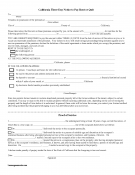 3-day notice to pay or quit – This is the notice that a landlord can serve if a tenant fails to pay rent within five days of the due date (§1161)
3-day notice to pay or quit – This is the notice that a landlord can serve if a tenant fails to pay rent within five days of the due date (§1161)
Download: Adobe PDF
Maximum Fees ($)
Late Rent Penalties
California generally does not permit late fees. Even if the fee is stated in the rental agreement, the burden is on the landlord to show that the fee is necessary. (See Orozco v. Casimiro.)
NSF Checks
A California landlord may assess a fee of up to $25 for providing the 1st check with insufficient funds to pay rent and $35 for any subsequent checks (§1719).
Tenant’s Unclaimed Property
Landlords have to catalog and maintain property left behind after the termination of a lease, whether the lease was ended voluntarily or involuntarily. Within fifteen (15) days of a tenant exiting the property, the landlord must mail the tenant a description of items left behind and inform them of the need to claim the property. The landlord may charge the tenant for the cost of storage while waiting.
The landlord has a duty of reasonable care to maintain the tenant’s property while in storage. If the tenant does not reply or reclaim the property worth less than $700, the landlord may dispose of it in any manner. However, if the property is worth more than $700, the landlord must dispose of it in a sale announced in a circulated publication. In either case, the landlord may use the proceeds of the sale to address unpaid obligations but must hold any remaining amount for the tenant for at least thirty (30) days after the sale (Chapter Five).
